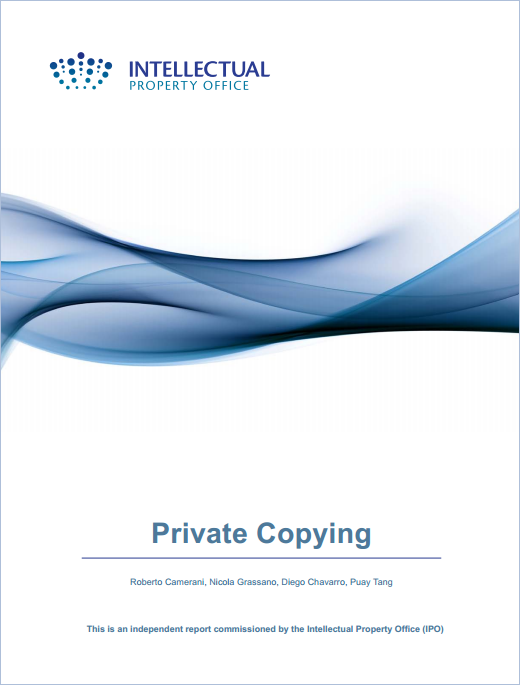Hoe vier auteursrechtindustrieën thuiskopiemaatregelen implementeren
Roberto Camerani, e.a., Private Copying, IPO | Patent Office 2013.
 De IPO (Verenigd Koninkrijk) heeft een studie gedaan naar hoe vier auteursrechtindustrieën thuiskopiemaatregelen hebben geïmplementeerd en of de kosten van het product (voldoende) het thuiskopierecht weerspiegelt.
De IPO (Verenigd Koninkrijk) heeft een studie gedaan naar hoe vier auteursrechtindustrieën thuiskopiemaatregelen hebben geïmplementeerd en of de kosten van het product (voldoende) het thuiskopierecht weerspiegelt.
Music database (5.94Mb)
Film database (907Kb)
eBook database (672Kb)
Software database (386Kb)
Main findings
Music: We did not find any evidence in support of a widely-held view that stores are including in their price the permission to copy. All digital albums are allowed to be copied for personal use, as opposed to CD albums that cannot be copied. In spite of this, we found that digital music is associated with a lower price compared to a CD. Whether the lower price depends on the store, on the intangible nature of the product, or on the possibility to copy, cannot be determined due to the lack of variability in the explanatory variables. However as private copying for personal use is widespread and allowed in the UK, it is plausible that private copying is already largely or fully priced in the UK market. Consumers and producers of music appear to expect that music will be copied for personal non-commercial use and all downloads are sold on these terms.
Films: In parallel with traditional films, which come with only one license (e.g. Blu-Ray and DVD), the film industry has found different ways to allow users to have more than one copy of the films they purchase. Examples can be found in the sales of digital films (which could be copied onto a number devices), by bundling multiple formats in the same package (which may also include a complimentary downloadable digital copy), or through new kinds of licenses, such as Ultraviolet. We found a positive relationship between price and film copies. In particular, since different types of formats have different impacts on price, we can conclude that film stores charge users not simply to have more copies, but to have the opportunity to choose from a higher variety of available choices.
Books: All the bookstores in the sample allow users to make copies of their eBooks. In particular, the copying terms and conditions are enforced using technologies embedded in the eBooks (DRMs) which are able to limit the number of copies that users is allowed and the kinds of devices in which the eBooks may be read on (e.g. smartphones, tablets, eBook readers). The influence of the number of copies allowed and the number of allowable devices on the price could not be determined because (1) of the lack of variability in the explanatory variables, and (2) to the fact that the large majority of price dissimilarities were captured by the difference between traditional books and eBooks. However, when considering that they are allowed to be copied, eBooks are on average less expensive than physical books (which are not allowed to be copied). This premium for a physical book is of course likely to be explained by manufacturing costs and the value consumers place on physical features, rather than on the number of copies that can be made from it.Software: This market case was used partly as a control case as it would notionally not be affected by a private copying exception. However, it is a sector, which actively tries to price for additional copies. The analysis suggests that software producers charge a price that reflects the possibility of making additional copies. In other words, a higher number of copies is associated with an increase in the price. However, this effect becomes smaller as the number of copies increases.





















































































